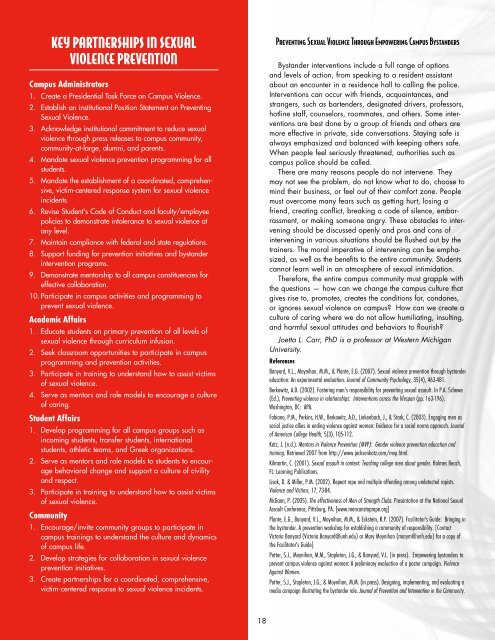Primary Prevention of Sexual Violence - American College Health ...
Primary Prevention of Sexual Violence - American College Health ...
Primary Prevention of Sexual Violence - American College Health ...
- No tags were found...
You also want an ePaper? Increase the reach of your titles
YUMPU automatically turns print PDFs into web optimized ePapers that Google loves.
KEY PARTNERSHIPS IN SEXUALVIOLENCE PREVENTIONCampus Administrators1. Create a Presidential Task Force on Campus <strong>Violence</strong>.2. Establish an institutional Position Statement on Preventing<strong>Sexual</strong> <strong>Violence</strong>.3. Acknowledge institutional commitment to reduce sexualviolence through press releases to campus community,community-at-large, alumni, and parents.4. Mandate sexual violence prevention programming for allstudents.5. Mandate the establishment <strong>of</strong> a coordinated, comprehensive,victim-centered response system for sexual violenceincidents.6. Revise Student's Code <strong>of</strong> Conduct and faculty/employeepolicies to demonstrate intolerance to sexual violence atany level.7. Maintain compliance with federal and state regulations.8. Support funding for prevention initiatives and bystanderintervention programs.9. Demonstrate mentorship to all campus constituencies foreffective collaboration.10. Participate in campus activities and programming toprevent sexual violence.Academic Affairs1. Educate students on primary prevention <strong>of</strong> all levels <strong>of</strong>sexual violence through curriculum infusion.2. Seek classroom opportunities to participate in campusprogramming and prevention activities.3. Participate in training to understand how to assist victims<strong>of</strong> sexual violence.4. Serve as mentors and role models to encourage a culture<strong>of</strong> caring.Student Affairs1. Develop programming for all campus groups such asincoming students, transfer students, internationalstudents, athletic teams, and Greek organizations.2. Serve as mentors and role models to students to encouragebehavioral change and support a culture <strong>of</strong> civilityand respect.3. Participate in training to understand how to assist victims<strong>of</strong> sexual violence.Community1. Encourage/invite community groups to participate incampus trainings to understand the culture and dynamics<strong>of</strong> campus life.2. Develop strategies for collaboration in sexual violenceprevention initiatives.3. Create partnerships for a coordinated, comprehensive,victim-centered response to sexual violence incidents.Preventing <strong>Sexual</strong> <strong>Violence</strong> Through Empowering Campus BystandersBystander interventions include a full range <strong>of</strong> optionsand levels <strong>of</strong> action, from speaking to a resident assistantabout an encounter in a residence hall to calling the police.Interventions can occur with friends, acquaintances, andstrangers, such as bartenders, designated drivers, pr<strong>of</strong>essors,hotline staff, counselors, roommates, and others. Some interventionsare best done by a group <strong>of</strong> friends and others aremore effective in private, side conversations. Staying safe isalways emphasized and balanced with keeping others safe.When people feel seriously threatened, authorities such ascampus police should be called.There are many reasons people do not intervene. Theymay not see the problem, do not know what to do, choose tomind their business, or feel out <strong>of</strong> their comfort zone. Peoplemust overcome many fears such as getting hurt, losing afriend, creating conflict, breaking a code <strong>of</strong> silence, embarrassment,or making someone angry. These obstacles to interveningshould be discussed openly and pros and cons <strong>of</strong>intervening in various situations should be flushed out by thetrainers. The moral imperative <strong>of</strong> intervening can be emphasized,as well as the benefits to the entire community. Studentscannot learn well in an atmosphere <strong>of</strong> sexual intimidation.Therefore, the entire campus community must grapple withthe questions — how can we change the campus culture thatgives rise to, promotes, creates the conditions for, condones,or ignores sexual violence on campus? How can we create aculture <strong>of</strong> caring where we do not allow humiliating, insulting,and harmful sexual attitudes and behaviors to flourish?Joetta L. Carr, PhD is a pr<strong>of</strong>essor at Western MichiganUniversity.ReferencesBanyard, V.L., Moynihan, M.M., & Plante, E.G. (2007). <strong>Sexual</strong> violence prevention through bystandereducation: An experimental evaluation. Journal <strong>of</strong> Community Psychology, 35(4), 463-481.Berkowitz, A.D. (2002). Fostering men’s responsibility for preventing sexual assault. In P.A. Schewe(Ed.), Preventing violence in relationships: Interventions across the lifespan (pp. 163-196).Washington, DC: APA.Fabiano, P.M., Perkins, H.W., Berkowitz, A.D., Linkenbach, J., & Stark, C. (2003). Engaging men associal justice allies in ending violence against women: Evidence for a social norms approach. Journal<strong>of</strong> <strong>American</strong> <strong>College</strong> <strong>Health</strong>, 5(3), 105-112.Katz, J. (n.d.). Mentors in <strong>Violence</strong> <strong>Prevention</strong> (MVP): Gender violence prevention education andtraining. Retrieved 2007 from http://www.jacksonkatz.com/mvp.html.Kilmartin, C. (2001). <strong>Sexual</strong> assault in context: Teaching college men about gender. Holmes Beach,FL: Learning Publications.Lisak, D. & Miller, P.M. (2002). Repeat rape and multiple <strong>of</strong>fending among undetected rapists.<strong>Violence</strong> and Victims. 17, 73-84.McGann, P. (2005). The effectiveness <strong>of</strong> Men <strong>of</strong> Strength Clubs. Presentation at the National <strong>Sexual</strong>Assault Conference, Pittsburg, PA. [www.mencanstoprape.org]Plante, E.G., Banyard, V.L., Moynihan, M.M., & Eckstein, R.P. (2007). Facilitator's Guide: Bringing inthe bystander. A prevention workshop for establishing a community <strong>of</strong> responsibility. [ContactVictoria Banyard (Victoria.Banyard@unh.edu) or Mary Moynihan (marym@unh.edu) for a copy <strong>of</strong>the Facilitator's Guide]Potter, S.J., Moynihan, M.M., Stapleton, J.G., & Banyard, V.L. (in press). Empowering bystanders toprevent campus violence against women: A preliminary evaluation <strong>of</strong> a poster campaign. <strong>Violence</strong>Against Women.Potter, S.J., Stapleton, J.G., & Moynihan, M.M. (in press). Designing, implementing, and evaluating amedia campaign illustrating the bystander role. Journal <strong>of</strong> <strong>Prevention</strong> and Intervention in the Community.18



![Final Program [5.4MB pdf] - American College Health Association](https://img.yumpu.com/49022356/1/190x245/final-program-54mb-pdf-american-college-health-association.jpg?quality=85)












